| J-7E/G INTERCEPTOR FIGHTER AIRCRAFT
中国空军J-7E/G截击战斗机 Date:2017-01-07 Source:Internet By:Globalmil Viewed: |
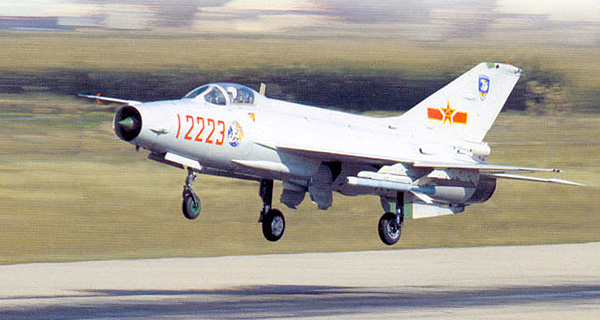
A PLAAF 1st Air Division J-7E taking off from the runway. The J-7E is the third-generation member of Chengdu’s long-lasting J-7 family. It is used by the PLAAF and PLANAF to replaced the ageing J-7B.来自PLAAF第一师J-7 E起飞。J-7 E是成都公司的长期J-7系列产品的第三代成员。它被PLAAF和PLANAF用于代替陈旧的J-7 B。
Chengdu Aircraft Industry Co (CAC) Jian-7E (J-7E) is an updated version of the original J-7 (Chinese copy of the MiG-21 Fishbed) with revised wing design and more modern avionics and weaponry. The export variant F-7MG/PG is fitted with Western-made radar and equipment. The J-7G is a further improved version introduced in 2002. The J-7E/G has been in service with the PLAAF and PLANAF since the mid-1990s to replace the existing J-7B.
成都飞机工业公司(CAC)歼(Jian)-7E(J-7 E)是J-7(米格-21 Fishbed的中国仿造型)的升级型,采用修改的机翼设计和较现代化的航空电子系统和武器系统。外销改型F-7 MG/PG安装使用西方-制造的雷达和设备。J-7 G是一种更进一步改良的型号在2002年推出。J-7 E/G从1990年代中期以后在PLAAF和PLANAF服役去代替已有的J-7 B。
PROGRAMME
计划
Chengdu began to develop a successor to its J-7B fighter in 1987. Improvements were made to overcome the weakness of the existing J-7B, including obsolete avionics, lack of all-weather, day/night combat capabilities, and poor aerodynamic performance in low-speed, low-altitude flight. CAC adopted a great deal of new technologies such as computer aided design and manufacturing (CAD/CAM), numerical control processing, laser/electromagnetic tests, composite materials, and high-pressured water cuts in the development. The resulting J-7E made its maiden flight in May 1990. By 1992 the fighter completed all flight tests and was ready for batch production.
成都公司开始在1987年对它的J-7 B战斗机发展一种后继机型。改进去克服J-7 B已存在的弱点,包括陈旧的航空电子系统,缺乏全天候、昼/夜战斗能力,和低速度、低高度飞行不足的空气动力学性能。在发展中大量采用CAC新的技术,像是计算机辅助设计和制造(CAD/CAM)、数控加工、激光/电磁测试、复合材料和高压水切割。制造的J-7 E在1990年5月作了它的首次飞行。在1992年战斗机完成了所有的飞行测试并且为批量生产做好准备。
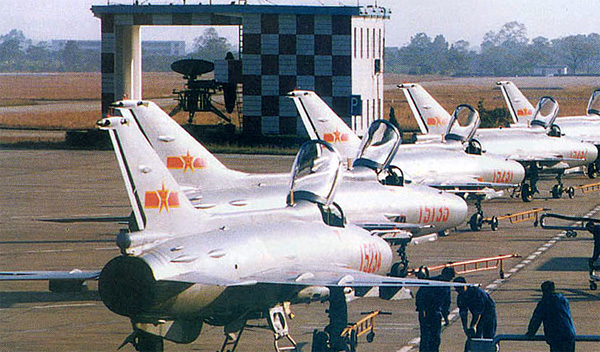
Ground crews refuelling a group of J-7E fighters belonging to the PLAAF 2nd Air Division. The J-7E is anticipated to remain in operational service for at least another decade, extending the service life of the long-lasting J-7/MiG-21 family to over half a century.地面人员给PLAAF第二师某团的J-7 E战斗机补给燃料。J-7 E在操作服役中被预期保持到至少另外的十年,把长期的J-7/米格-21系列产品的有效寿命扩充到了半个世纪。
The J-7E is based on the airframe of the J-7B, but its wings have been changed to a unique "double delta" design offering improved aerodynamics and increased fuel storage capability. The aerodynamic performance of the aircraft is further improved by the introduction of a more powerful WP-13F turbojet. Compared to the J-7B, the J-7E’s sea-level climbing rate has increased from 155m/s to 195m/s; the internal fuel capacity has increased from 2,080kg to 4,165kg; the ferry range has increased from 1,500km to 2,200km; the G limit has increased from 7 to 8. The maximum instantaneous turn rate of the J-7E is 25.2 degree/s, and the maximum sustained turn rate at 1,000m altitude is 16 degree/s. According to CAC, the overall aerodynamic performance of the J-7E has increased by 43%, and the combat effectiveness has increased by 84% compared to the J-7B.
J-7 E以J-7 B的机身为基础,但是它的机翼改变到一种独特的“双三角”设计提供改良空气动力学和增加燃料存储能力。飞机的空气动力学的性能被功率更大的WP-13F型涡喷发动机更进一步改良。与J-7 B、J-7 E海平面爬升率比较,从155米/秒增加到195米/秒;内部燃料容量从2,080公斤增加到4,165公斤;转场航程从1,500公里增加到2,200公里;G-极限从7增加到8。J-7 E的最大瞬时盘旋率是25.2度/秒,而且最大持续盘旋率在1,000米高度是16度/秒。依照CAC所称,J-7 E的全部空气动力学的性能增加了43%,而且战斗效能与J-7 B比较增强了84%。
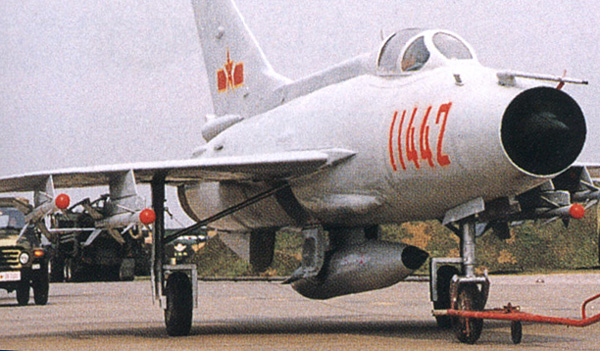
The J-7E can carry up to four PL-8 short-range air-to-air missiles for close air combat.J-7E能携带用于近距离格斗的四枚PL-8近程空对空导弹。
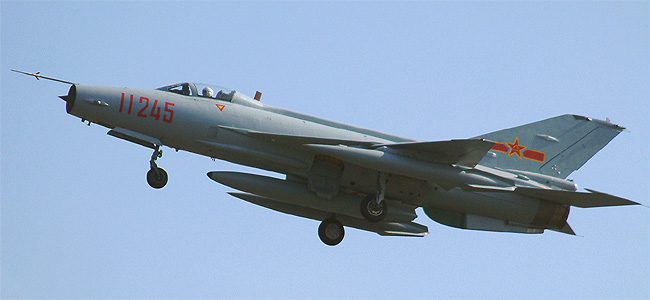
A PLAAF 3rd Air Division J-7E taking off. The J-7E are deployed by most elite units in the PLAAF and PLANAF.PLAAF第三师J-7 E起飞。J-7 E被PLAAF和PLANAF的最大多数的精华单位部署。
Chengdu revealed its F-7MG, the export version of the J-7E, in the 1996 Zhuhai Airshow. The F-7MG is fitted with GEC-Marconi Super Skyranger PD fire-control radar and electronic countermeasures (ECM) suite, as well as a Martin-Baker zero/zero ejection seat. The Pakistani Air Force (PAF) has ordered two batches (57 aircraft in total) of F-7PG fighters, a variant based on the F-7MG with specified modifications under the requirements of the PAF.
成都公司在1996年珠海航展(Zhuhai Airshow)上展示了它的F-7 MG,J-7 E的外销型。F-7 MG配备有GEC-马可尼超级Skyranger PD火控雷达和电子对抗(电子干扰)组件,和一种马丁-贝克零/零弹射座椅。巴基斯坦空军(PAF)已经订购两批(总数57架)F-7 PG战斗机,基于F-7 MG的改型,在PAF需要下进行了指定的修改。
J-7 G战斗机
A further improved version of the J-7E, known as J-7G, was first spotted under flight test in 2002. The J-7G is similar to the J-7E in basic aerodynamic layout, but has upgraded avionics. The J-7G is said to be fitted with a new indigenous KLJ-6E pulse-Doppler fire-control radar, which may be a Chinese copy of the Israeli EL/M2001 optimised for PL-8B and PL-5C short-range AAMs. A new electronic countermeasures (ECM) suite includes a Type-III all aspect radar warning receiver (RWR) and chaff/flare dispenser.
J-7 E的一个较进一步改良型,即是J-7 G,在2002年飞行测试时被首次看见。J-7 G与基本型J-7 E的空气动力学的设计类似,但是已经升级航空电子系统。J-7 G据说配备有一个新的自行研制的KLJ-6E脉冲-多普勒火控雷达,可能是中国仿造以色列EL/M2001 optimised用于PL-8B和PL-5C近程AAM。一种新的电子对抗(电子干扰)组件包括III-型全向雷达告警接收机(RWR)和箔丝/闪光弹释放器。
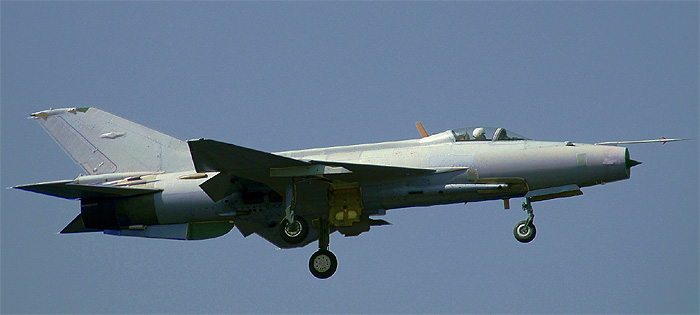
The J-7G first introduced in 2002 is an improved version of the J-7E with better avionics. The fighter first flew in June 2002 and the batch production began in early 2003, replacing the production of the J-7E.J-7G在2002年首次生产具有更好的航空电子系统的J-7 E的一个改良型。战斗机在2002年6月首次飞行,而且批量生产在2003年开始,代替J-7 E的生产。
The J-7G also features a single-piece curving windscreen in place of the original three-segment windscreen. A new type of communications antenna is located behind the canopy. Additionally the J-7G might also be fitted with hamlet-mounted sight (HMS) for close air combat. As a result of the increased avionics weight, Chengdu engineers had to remove one 30mm cannon onboard, leaving the aircraft with only one cannon (60 rounds).
J-7 G的特点在最初的三段风挡玻璃位置以单块圆弧形风挡玻璃代替。一个新型通信天线位于座舱盖之后。附加地J-7 G也能为近距离空战配备有头盔安装瞄准器(HMS)。由于导致增加航空电子系统重量,成都工程师必须去掉机载一门30毫米机炮,这时飞机仅有一门机炮(60发弹药)。
VARIANTS
改型

An “August 1st” Aerobatic Demonstrate team J-7G landing on the runway. The improved J-7G features a single-piece curving windscreen in place of the original three-segment windscreen.“八一”特技飞行队的J-7 G在跑道上降落。J-7 G的特点用一块圆弧形风挡玻璃代替最初的三段风挡玻璃。
|
命名
|
第一次飞行
|
描述
|
| J-7 E | 1990 | J-7 B的升级型J-7 E |
| F-7 MG | N/A | 外销型 |
| J-7 EB | N/A | 一个特别改型在PLAAF“八一”特技飞行队使用 |
| J-7 G | 2002 | 改进型采用更好的航空电子系统 |
DESIGN
设计
The unique double-delta-shape wing of the J-7E designed by Northwest Polytechnic University (NPU) has a slightly larger wingspan and wing area, giving the J-7E a bigger internal fuel capacity and better manoeuvrability. The original WP-7B turbojet was replaced by an improved WP-13F. The J-7E is comparable in manoeuvrability and general performance to early versions of the F-16A/B, and can make a serious challenge to a modern fighter in 'dog fight' air combat.
被西北工业大学(NPU)设计的J-7 E采用独特的双三角形机翼,具有一些稍微增大的翼展和机翼面积,给J-7 E更大的内部燃料容量和更好的机动性。最初的WP-7B涡喷发动机被改良的WP-13F发动机代替。J-7 E可比得上F-16 A/B的早期型号的机动性和综合性能,而且在“混战”空中格斗中能对一架现代化战斗机作严重的挑战。
WEAPONS
武器
Fixed weapon includes two (J-7G only has one) 30mm Type 30-1 cannon with 60 rounds per gun in the lower sides of the fuselage. Four under-wing stores stations can carry up to 2,000kg of disposable stores (each unit rated at 500kg), typical weapons are PL-8, and PL-9 short-range AAMs, free-fall weapons such as 500, 250, 100 and 50kg bombs, and multiple launchers each carrying twelve 55mm or seven 90mm unguided rockets. Centre fuselage station and two outboard wing stations are pumped to carry 720 litre drop tanks.
固定的武器包括在机身下侧两门30毫米30-1型机炮连同60发弹药(J-7 G只有一门)。四个在机翼下挂架能携带至多2,000公斤负载(每个单位额定500公斤),典型的武器是PL-8和PL-9近程AAM;空投武器,如500公斤、250公斤、100公斤和50公斤炸弹;多管发射装置,每个携带十二枚55毫米或七枚90毫米非制导火箭。机身中部位置和二个外侧机翼位置被携带720升外挂油箱。
AVIONICS
航空电子系统
Avionics configuration varies on different variants.
航空电子系统配置在不同改型上改变。
Fire-control: Three options are available for the fire-control radar on J-7E/F-7MG series:
火控,三个选择项可用来在J-7 E/F-7 MG系列上的火控雷达:
The GEC-Marconi Super Skyranger PD fire-control radar, X-band, detect-range of 15km, look-down, shoot-down, track up to 8 targets simultaneously.
The Italian Grifo-7 fire-control radar, I-band, detect-range of 55km.
Indigenous Type 226 PD fire-control radar (J-7E).
New indigenous PD fire-control radar (J-7G)
If necessary, the J-7E could also easily adopt the helmet-mounted sight (HMS) for better combat effectiveness.
GEC-马可尼超级Skyranger PD火控雷达,X波段,探测-15公里的范围,下视,下射,同时追踪达到8个目标。
意大利Grifo-7火控雷达,I-波段,探测-55公里的范围。
自行生产的226 PD型火控雷达(J-7 E)。
新的自行生产的PD火控雷达(J-7 G)。
如果必需,J-7 E可以为更好的战斗效能能容易地采用头盔安装显示器(HMS)。
Flight: WL-7 radio compass; 0101 HR A2 altitude radio altimeter; LTC-2 horizon gyro; XS-6 marker beacon receiver; VOR; Distance Measure Equipment (DME); Instrument Landing System (ILS), TAKAN navigation system.
飞行:WL-7无线电罗盘;0101 HR A2高度无线电测高计;LTC-2水平陀螺仪;XS-6信号指示接收器;VOR;距离测量设备(DME);仪器导降系统(ILS);TAKAN导航系统。
Self-defence: South-West China Research Institute of Electronic Equipment KG-8602 RWR interfaced with the South-West China Research Institute of Electronic Equipment KG-8605 internal radar noise jammer and China National Import and Export Corporation GT-1 chaff/flare dispenser, and Type-602 'Odd Rods' IFF.
自防卫:中国西南电子设备研究所KG-8602 RWR界面和中国西南电子设备研究所KG-8605内部雷达噪声干扰机,中国国家进出口公司GT-1箔丝/闪光弹释放器和602型“Odd Rods”IFF。
Avionics upgrades include a new head-up display (HUD), radar warning receiver (RWR), air data computer, GPS and inertial navigation system (INS), and a new pulse-Doppler fire-control radar based on Russian or Israeli technology.
航空电子系统升级包括一个新的平视显示装置(HUD),雷达告警接收机(RWR),空气数据计算机,全球定位系统和惯性导航系统(INS)和基于俄国或以色列技术的一部新的脉冲-多普勒火控雷达。
POWERPLANT
动力装置
One Liyang (LMC) Wopen-13F (R-13-300) turbojet rated at 44.1kN dry and 66.7kN with afterburning. Nose air inlet.
一台Liyang(LMC) Wopen-13 F(R-13-300)涡喷发动机,额定净推力44.1kN和加力燃烧66.7kN。机鼻进气口。
SPECIFICATIONS
规格
Crew: 1
Dimensions: Wingspan: 8.32m; Length: 14.885m; Height: 4.103m
Weight: Empty: 5,292kg; Normal take-off: 7,540kg; Maximum take-off: 9,100kg
Max Speed: Mach 2.0
Radius: (Long-range interception with two AAMs and three 720 liter drop tanks at speed of Mach 1.5) 850km; (Interception with two bombs and three 720 liter drop tanks, lo-lo-hi) 550km
Range: ferry range 2,200km
Service Ceiling: 18,800m
Max Climb Rate: 195m/s (sea level)
G limit: -3 to +8 (5,000 m)
组员: 1名
尺寸: 翼展,8.32米;长度,14.885米;高度,4.103米
重量: 空重,5,292公斤;正常起飞,7,540公斤;最大起飞,9,100公斤
最大速度: Mach 2.0
作战半径: (二枚AAM和三个720公升外挂油箱的远程拦截以Mach 1.5的速度)850 公里;(使用二枚炸弹和三个720公升外挂油箱,lo-lo-hi)550 公里
航程: 转场航程 2,200公里
实用升限: 18,800米
最大爬升率: 195 米/秒(海平面)
G 极限: -3 到 +8(5,000 米)
上一篇:Chengdu J-20 Multirole Stealth Fighter Aircraft,China 下一篇:J-8II MULTIROLE FIGHTER AIRCRAFT
| Jian-9(J-9)Fighter aircraft
中国歼-9(J-9)战斗机 |
| The J-9 designation was apparently initially applied to an unbuilt single engine development of the J-8 aircraft that was cancelled in development around 1979. ... [2020-04-05] |
| Shenyang J-31
中国沈阳J-31型隐形战斗机 |
| The Shenyang J-31(or "FC-31 fifth Generation Multi-Purpose Medium Fighter") also known as the "Gyrfalcon" (鹘鹰), or "Falcon Hawk" by some military enthusiasts,is a twin-engine, mid-size fifth-generation jet fighter currently under develop... [2017-08-02] |
| Jian-10B Multirole Fighter Aircraft
中国J-10B多任务战斗机 |
| The J-10B is a modified variant of the J-10 multirole fighter aircraft, with modifications in airframe and avionics. ... [2017-02-18] |
| J-8II MULTIROLE FIGHTER AIRCRAFT
J-8II多任务战斗机 |
| The Jian-8II (J-8II, NATO codename: Finback-B) is a single-seat, twin-engine multirole fighter aircraft developed by Shenyang Aircraft Industry Co. (SAC) based on its J-8I fighter. ... [2017-02-18] |
